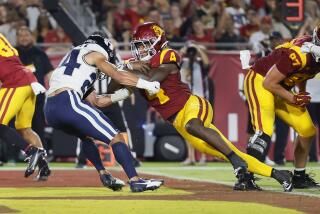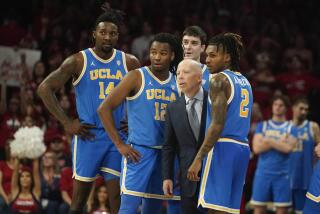Struggling SDSU Looks for Answers : Aztecs Trying to Lose That Losing Feeling
- Share via
SAN DIEGO — The question is most obvious because it haunts the San Diego State football team every day. The players and coaches have theories but no definitive answer. So they ask and answer the question--over and over.
The question is simple to phrase: What is wrong with Aztecs? Finding an answer will take much longer.
In the steam and sullenness of another losing locker room Saturday, senior strong safety Harold Hicks was asked the obvious. He tried his best to explain.
He leaned forward, so close that the breath from his last word hung on the air of the next. He spoke with deliberate urgency. His tone was as if he was sharing a secret of the universe. He began with a mild expletive. This was important stuff.
”. . . The team we had last year, not to say we’re not hungry this year, but the team had last year had 30-35 seniors that were here for five years,” Hicks said. “They were starrrving . They were starrrving for a championship.”
Hicks leaned even closer, almost uncomfortably so. Now was time for a confession.
“At the beginning of this season I didn’t think senior leadership would be a problem, but I guess you could say it is. Like Coach (Denny) Stolz was saying, rookie NFL teams don’t win it; veterans take teams to the Super Bowl,” Hicks said. “Last year’s team was hungry. We’re hungry , but it’s just not coming together.”
Hicks bowed and shook his head. His emotion was frustration, not anger. Trying to answer the question provided a catharsis, but not relief.
What frightens the Aztecs is not that they’re losing, but that they can’t seem to stop.
“I don’t know what it is,” said Lyndon Earley, sophomore free safety. “I don’t have a clue.”
A preseason poll of the Western Athletic Conference coaches selected the Aztecs to repeat as conference champions. As the season approaches the halfway point, that prospect seems remote. The Aztecs are 1-2 in the conference and 1-4 overall. They return to San Diego Jack Murphy Stadium Saturday night for the first time in a month to play Texas El Paso (2-0, 3-1), the WAC co-leader.
All four of SDSU’s loses were on the road. In those defeats, the Aztecs were outscored, 173-51. Take away the 25-20 loss at Oregon two weeks ago, and they have been beaten, 148-31, in three lopsided defeats to UCLA (47-14), Air Force (49-7) and Wyoming (52-10). Their only victory was against Utah (52-34) in the second week of the season at home.
“Obviously nobody knows what’s wrong,” said Chuck Nixon, senior linebacker. “I’ve tried to put a handle on it, but I just can’t figure it out. I look in the locker room and I see talent there. I know we’ve got the players. Why we haven’t done it, I just don’t know.”
The most frequent theory is the one that Stolz proposed and Hicks endorsed: The Aztecs are an amalgamation of talent that has yet to find a bond.
“There are a lot of different elements on this football team,” Stolz said. “Last year it was a very definite senior leadership football team--dominant leadership. This team is a combination of freshmen, veterans and junior college transfers all thrown together.
“I don’t have a formula for it. Sometimes it takes time for a team to come together.”
That task can be difficult for a team that was expected to do well but faltered from the start. An infusion of transfers and freshman does not make it easier. Unfamiliarity makes finger pointing that much easier. The loss at Air Force, in which the defense played its worst game of the season, triggered a mild form of dissension.
“It kind of started up, and we had a meeting to shut it down real fast,” said Kevin Wells, junior center. “People have to take responsibility for their mistakes. You can’t start finger pointing. That is what tears a team apart real quick.”
The Aztecs were given false hope that the unifying process was working after their loss at Oregon. The controversial finish, in which quarterback Todd Santos was penalized for throwing the ball out of bounds to stop the clock and the other 17 penalties that were called against them, became a rallying point.
The locker room was filled that afternoon with players vowing to come back from such a controversial defeat, pledging that adversity had taught them a lesson in togetherness. That lasted for all of one half against Wyoming.
Trailing, 17-10, the Aztecs fell apart in the third quarter. They failed to gain a first down, surrendered 28 points and scored none. A close game quickly turned into a blowout.
It was after that loss that the question become more a plea: What is wrong with the Aztecs? After the game, Stolz said his team was flat. Why, he did not know. It has been that kind of season, more questions than answers.
“It’s a combination of things,” Stolz said. “After the Oregon ballgame, I saw more togetherness. After that ballgame, I really thought the ballclub was coming together. That is what is so mystifying about the second half against Wyoming. We were a good football team in the first half and then we just went flat.”
One problem Stolz has acknowledged is the schedule. The Aztecs played four of their first five games on the road. Five of their final seven are at home, including three in a row, starting with UTEP. But their remaining two road games are against Hawaii and Brigham Young, two of the conference’s stronger teams. Most football schedules are made years in advance, and Stolz and Athletic Director Fred Miller, both of whom were hired in the past two years, had to work with what they inherited.
“Fred Miller would never put a ballclub on the road for four of its first five games. Nobody has to do that. Nobody in the pros, nobody in college.
“I talked about this before the season. Had we won those games, you’d have heard me saying, ‘That’s a real crisis behind us. Now the schedule really favors us.’ It was the same thing a year ago. I said if we get to the last three games still in the championship picture, we’ll be tough. That’s exactly how it worked out. We got to the last three games tied for first place and won them all at home. We got over the crisis last year; we didn’t make it this year.”
Scheduling and leadership are acknowledged problems, but judging talent and performance can be more difficult questions. Before the season, Stolz cited several problem positions, primarily linebacker, wide receiver and running back. He never mentioned the secondary. Now he is.
The secondary of Earley and Hicks at safeties and Mario Mitchell and Clarence Nunn at the cornerbacks was supposed to be the Aztecs’ most experienced area. Instead, injuries and coverage mistakes have helped the Aztecs rank 102 of 104 National Collegiate Athletic Assn. Division I-A teams in overall defense, allowing an average of 494 yards per game.
“At times, our secondary coverage has gotten us into some trouble,” Stolz said. “I thought we’d be better cover people than that. We’ve had some injuries back there, too. But I’m little bit disappointed because that was supposed to be a real strength. We had every reason to expect it because we had experienced people coming back.”
The secondary took a pounding early in the season. Its four starters were ranked among the team’s seven leading tacklers through the first three games before injuries forced Mitchell (sprained knee) and Nunn (bruised shoulder nerve) out of the Oregon game, and kept Hicks (bruised thigh) at less than full strength.
“When your secondary is making your tackles, hang on,” Stolz said, “and the didn’t hold on. They’ve been hurt.”
The injuries and poor play have caused the defense to be the team’s most unsettled area. Only three players have started the same position every game--Earley, Hicks and Brett Faryniarz at defensive end. The Aztecs have used 20 different starters on defense.
More to Read
Go beyond the scoreboard
Get the latest on L.A.'s teams in the daily Sports Report newsletter.
You may occasionally receive promotional content from the Los Angeles Times.










